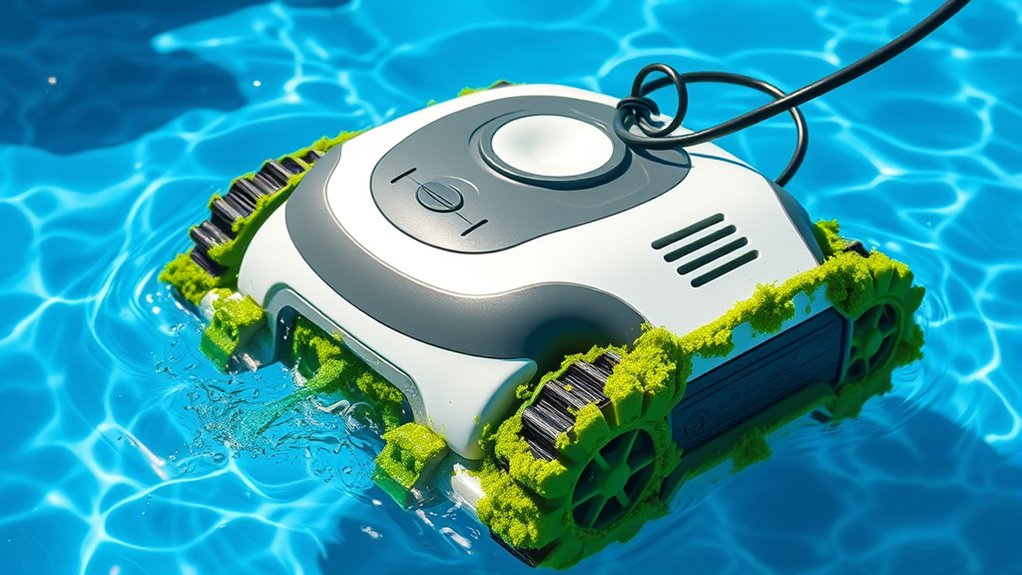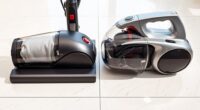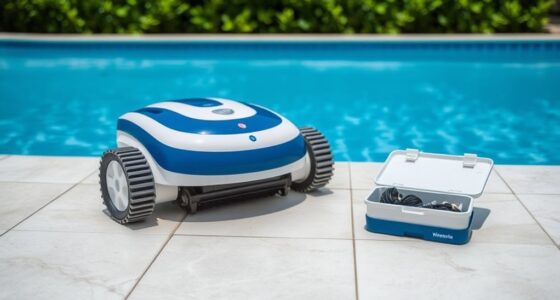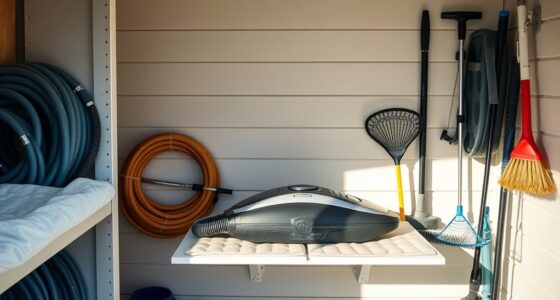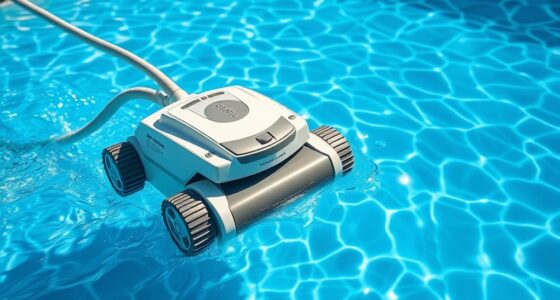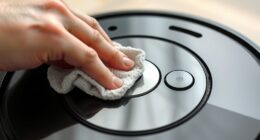If your robotic pool cleaner isn’t working well, start by checking for navigation issues like dirty sensors or debris buildup on wheels and brushes. Make sure it’s properly charged, connected, and update its software if needed. Clean filters and ensure the power supply and connections are secure. Regular maintenance on these parts prevents future problems. For more tips on troubleshooting your cleaner effectively, keep exploring to find detailed solutions tailored to common malfunctions.
Key Takeaways
- Check and clean sensors, brushes, and wheels regularly to prevent debris buildup and ensure smooth navigation.
- Confirm the robotic cleaner’s battery is charged, properly seated, and that the charging station is correctly positioned and clean.
- Reset the device and Wi-Fi router if experiencing connectivity issues; update firmware and software regularly.
- Inspect for and remove blockages or damage in water flow pathways, filters, and robotic arms to maintain optimal cleaning performance.
- Perform routine diagnostics, monitor error codes, and address mechanical or electrical faults promptly to prevent further damage.
Common Navigation and Mobility Problems
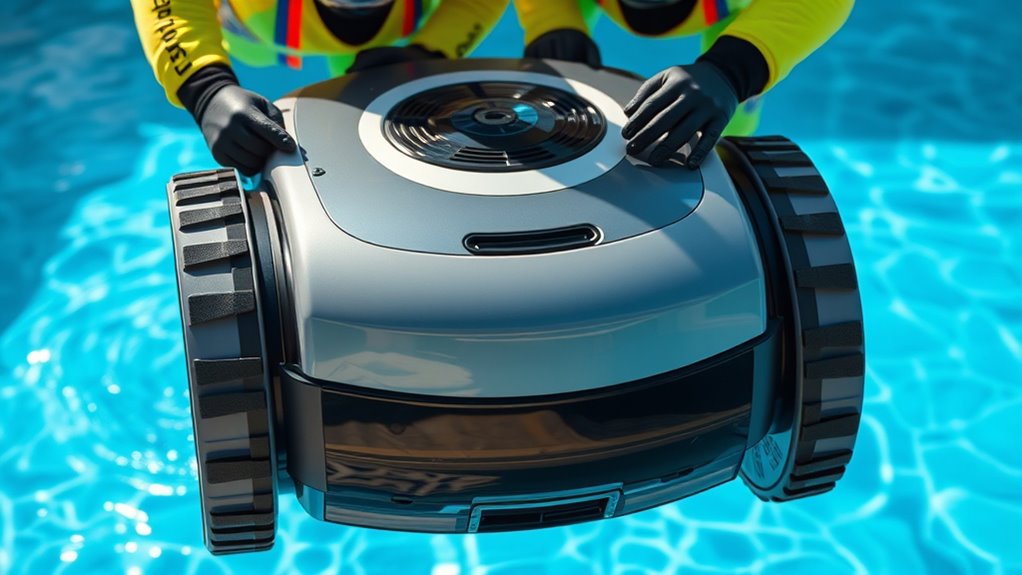
Navigation and mobility issues are among the most frequent problems you might encounter with robotic pool cleaners. If your cleaner struggles to move properly, it could be due to faulty obstacle detection sensors or poor wheel traction. When obstacle detection isn’t working correctly, your robot might get stuck or miss areas, so verify sensors are clean and free of debris. Low wheel traction can cause the cleaner to slip or not climb over small obstacles or pool steps. Check the wheels for debris or damage, and if needed, adjust their grip or replace them. Regular maintenance of sensors and wheels helps maintain smooth navigation. Additionally, inspecting sensor calibration can ensure accurate obstacle detection and improve movement. Proper calibration is crucial for effective navigation, which directly impacts the cleaner’s efficiency. You should also consider filter replacement timing, as clogged filters can affect the robot’s mobility and overall performance. Moreover, worn wheels can reduce traction and hinder movement, so inspecting and replacing them when necessary is recommended. Keep in mind that region-specific pool conditions can influence how well your robot performs, so adjusting settings accordingly can help. By addressing these issues, you’ll improve your cleaner’s ability to move efficiently and cover the entire pool surface.
Addressing Power and Connectivity Issues
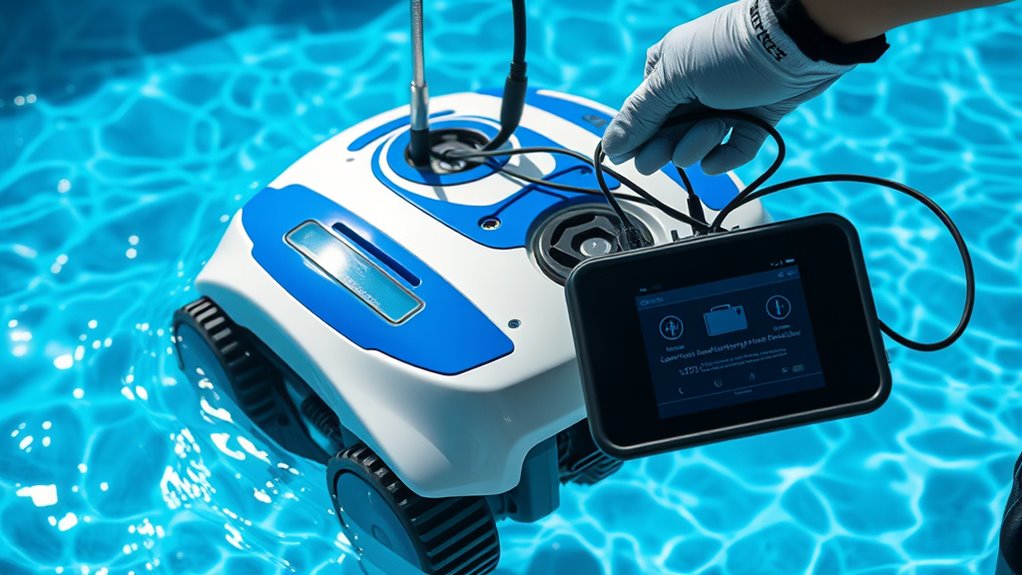
Power and connectivity problems are common hurdles when using robotic pool cleaners, often causing interruptions during cleaning cycles. If your cleaner isn’t responding to the remote control, first check the power source and make certain batteries are charged or replaced. Make sure the unit is properly connected to its dock and that there are no obstructions blocking signals. Connectivity issues can also stem from outdated software; regularly check for software updates, which can improve communication between your cleaner and remote or app. Resetting the device or restarting your Wi-Fi router can also resolve persistent connection problems. Maintaining a clear, interference-free environment helps ensure smooth operation. Hydrocolloid technology promotes healing by drawing out impurities and is a good example of effective acne treatment. By staying attentive to power sources and keeping your software current, you reduce the chances of interruptions during your pool cleaning routine. Additionally, wireless connectivity can be affected by electronic interference from other devices, so minimizing nearby electronics can help maintain a stable connection. Furthermore, understanding the Kia Tuning process can help optimize your vehicle’s performance and reliability, much like maintaining a robust connection for your cleaner.
Fixing Suction and Cleaning Performance Failures
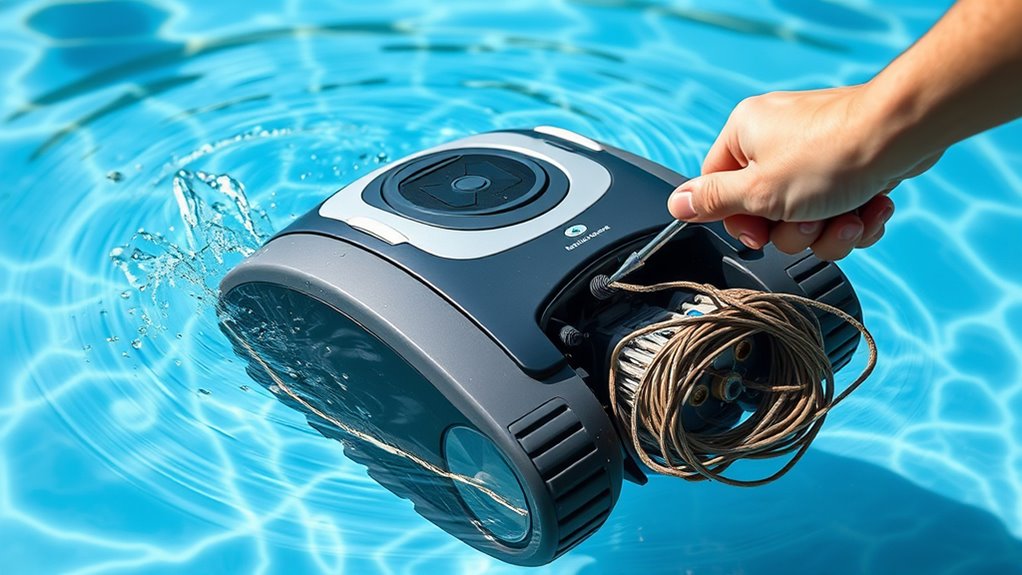
When your robotic pool cleaner isn’t picking up debris effectively or seems to lose suction, it’s often due to clogs or blocked filters. Check the filter for debris buildup or clogging, and clean it thoroughly if needed. A clogged filter reduces water flow, impairing suction and cleaning performance. Additionally, a robotic arm malfunction can hinder debris collection, causing missed spots or incomplete cleaning. Inspect the robotic arm for obstructions or damage, and ensure it moves freely. Clearing blockages and fixing mechanical issues usually restores maximum suction. Regular maintenance, like cleaning filters and inspecting the robotic arm, prevents these failures. Performing routine filter maintenance can significantly improve the device’s overall efficiency. Also, ensure the suction pathways are free from obstructions, which can further impair performance. Proper water flow management is essential for maintaining optimal suction and cleaning effectiveness. Inspecting for air leaks and ensuring seals are intact can also help maintain proper pressure and flow. If problems persist, consider replacing damaged parts or consulting the manufacturer’s troubleshooting guide for specific model recommendations. To further enhance performance, ensuring the robotic cleaner’s engine tuning and calibration aligns with manufacturer specifications can help optimize its operation.
Troubleshooting Battery and Charging Concerns
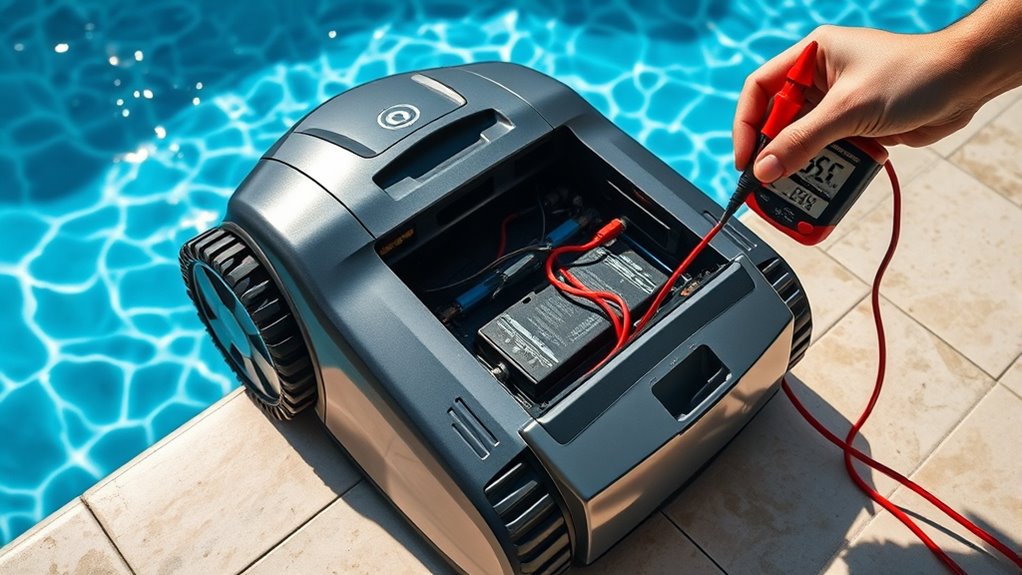
If your robotic pool cleaner is struggling to operate or won’t hold a charge, battery and charging issues might be be the cause. Check the battery lifespan; batteries naturally degrade over time, reducing runtime. Ensure the charging station is correctly placed—away from obstacles and direct sunlight—to optimize charging efficiency. Proper placement prevents connectivity issues and ensures consistent power. If the cleaner isn’t charging, inspect the charging contacts for dirt or corrosion. Sometimes, resetting the unit or replacing the battery is necessary. Here’s a quick reference:
| Issue | Solution | Tips |
|---|---|---|
| Battery not holding charge | Replace battery | Use authentic parts |
| Poor charging connection | Clean contacts | Avoid debris buildup |
| Inconsistent charging | Reposition station | Keep station in shaded area |
| Shorter runtime | Upgrade battery | Check battery age |
Understanding battery health and implementing proper charging procedures can help extend your cleaner’s performance. Maintaining battery performance and ensuring proper charging procedures are essential for optimal operation.
Maintenance Tips to Prevent Future Malfunctions
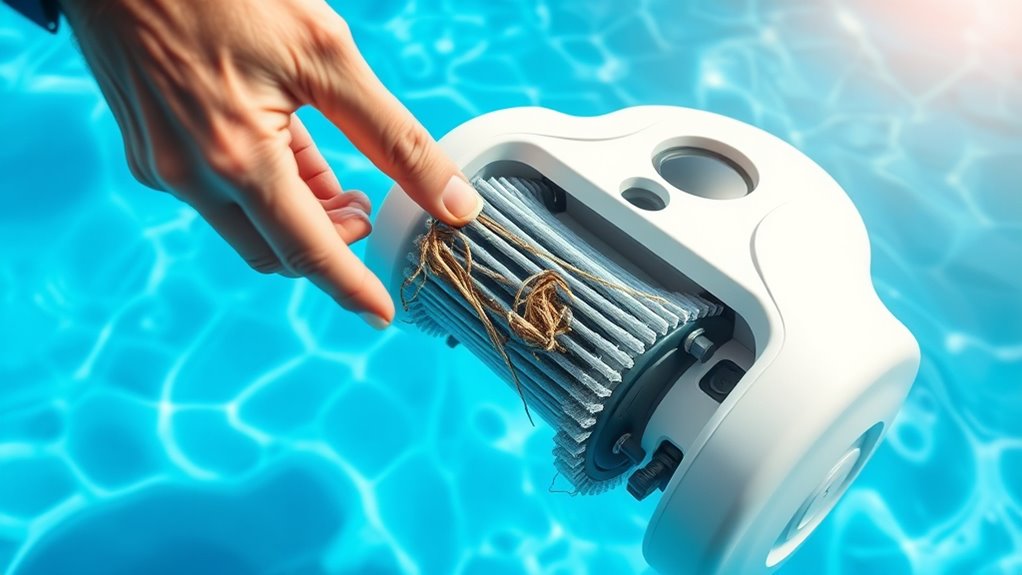
Regular maintenance is essential to keep your robotic pool cleaner running smoothly and prevent future malfunctions. Start by regularly updating your robotic software; manufacturers often release updates that improve performance and fix bugs. Check the software periodically and install updates promptly. Additionally, prioritize filter maintenance—clean or replace filters as recommended to ensure ideal suction and prevent clogs. A clean filter reduces strain on the motor and prolongs your cleaner’s lifespan. Inspect the brushes and wheels for debris and wear, and remove any obstructions. Keep the unit’s housing and sensors clean to maintain navigation accuracy. Regularly checking the noise levels of modern heat pumps can also help you identify if your equipment is functioning unusually, which might indicate a need for professional servicing. It is also beneficial to review your home maintenance schedule regularly to ensure all components are functioning correctly. Staying informed about air quality considerations can help you recognize issues that may affect your robot’s operation and efficiency. Additionally, monitoring the power supply and connections ensures consistent operation and prevents electrical issues. Incorporating routine system diagnostics can help detect potential problems early and keep your robotic cleaner in optimal condition. By staying proactive with software updates and filter maintenance, you minimize the risk of breakdowns and extend your robotic cleaner’s efficiency, saving you time and money in the long run.
Frequently Asked Questions
How Often Should I Replace My Robotic Pool Cleaner’S Brushes?
You’re wondering how often to replace your robotic pool cleaner’s brushes. For ideal brush maintenance, check them regularly and replace them every 6 to 12 months, depending on usage and wear. If you notice the brushes become frayed, cracked, or lose their stiffness, it’s time for a replacement. Following the recommended replacement schedule ensures your cleaner works efficiently and extends its lifespan. Regular upkeep keeps your pool sparkling and clean.
Can I Use My Robotic Cleaner on a Variable-Speed Pool Pump?
You can use your robotic cleaner with a variable-speed pool pump, but you should check its compatibility first. Some robotic cleaners are designed specifically for standard pumps, while others support variable-speed operation. Verify yours is compatible with variable-speed pumps to avoid issues like insufficient power or excessive energy use. Look at the manufacturer’s guidelines or contact support to confirm pool pump compatibility and ensure smooth operation without damaging your cleaner.
What Should I Do if My Robot Gets Stuck on Pool Steps?
Your robotic cleaner getting stuck on pool steps is like hitting a brick wall! To fix this, check its pool step navigation and make sure it’s programmed for obstacle avoidance strategies. You can also manually guide it past stubborn spots or adjust its direction. Regularly cleaning sensors and removing debris helps improve obstacle detection, preventing future snags. With these steps, your robot will glide smoothly, conquering every corner of your pool effortlessly.
How Do I Reset My Robotic Pool Cleaner to Factory Settings?
To reset your robotic pool cleaner to factory settings, start by turning it off. Then, perform a firmware upgrade if available, which often restores default settings. You may also need to recalibrate the battery by removing and reinserting it, then charging fully. This process resets your device, ensuring it operates smoothly. Always consult your user manual for specific instructions tailored to your model.
Is It Safe to Leave the Robotic Cleaner in the Pool Overnight?
Leaving your robotic pool cleaner in the pool overnight is generally safe, but consider your pool chemistry and energy use. If your pool’s chemistry is balanced, it won’t harm the cleaner, and leaving it submerged can save energy by avoiding daily setup. However, check your cleaner’s manufacturer guidelines, as prolonged exposure might cause wear. Keeping an eye on pool chemistry helps make certain of safe, efficient operation without unnecessary energy consumption.
Conclusion
By tackling these common robotic pool cleaner issues, you’ll keep your device running smoothly and extend its lifespan. Regular maintenance and prompt troubleshooting can save you time and money down the line. Remember, a stitch in time saves nine—address problems early before they become bigger headaches. Stay attentive to your cleaner’s needs, and you’ll enjoy a sparkling pool all season long with fewer surprises along the way.
